A number of Bishop Manogue High School students met with military journalist and author Steve Ranson to give their impressions of the World War II Museum with local veterans. From left are Audrey Sheldon, Eva Wathen, Ryan Clark, Aiden McCaffrey, Ranson, Couper Ross, Ben Enos, Sean McCorey and adviser Sarah Haeberlin-Cope. On behalf of Honor Flight Nevada, each student received a book on World War II veterans with Nevada ties.
It was the trip of a lifetime for both students and veterans old enough to be their grandparents.
Generation Z, meet The Greatest Generation — the men and women who fought in the Pacific or on the European continent in World War II from late 1941 to 1945 — or others who saw action on the Korean peninsula from 1950-1953.
For four days earlier this autumn, 20 seniors from Bishop Manogue High School in Reno were matched with a veteran and guardian during a whirlwind trip from Reno to the World War II Museum in New Orleans.
Sara Haeberlin-Cope, an adviser at Manogue High School who accompanied the students, said a little “Lady Luck” provided the students with an opportunity to accompany the men and women who served their country more than a half century ago.
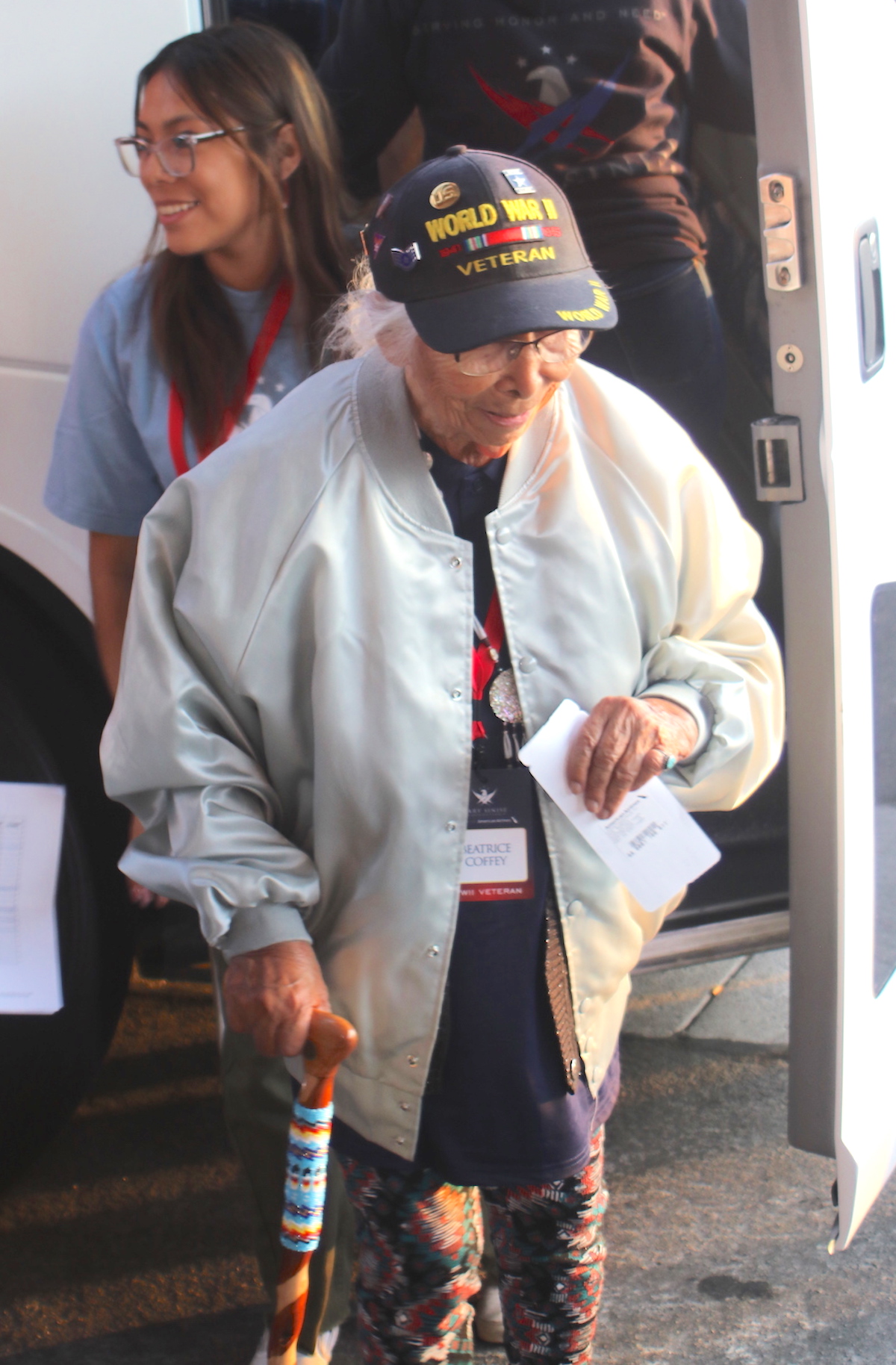
Steve Ranson/Nevada News Group
Bea Thayer made the military a career which began during the later years of World War II.
“The Gary Sinise Foundation reached out to us and asked if we were interested,” Haeberlin-Cope said. “We didn’t drop a beat and said “yes.” We had about two weeks notice before the trip.”
Haeberlin-Cope said a parent of one of their teachers asked if Bishop Manogue High School would be interested in selecting students to travel to the World War II Museum. It worked well for Manogue, and the planning began to fall in place for their Solar Valor trip to New Orleans. It also was a coincidence that a teacher’s parent worked for American Airlines.
The Gary Sinise Foundation and American Airlines invited the students, 15 veterans and guardians as their guests on the trip. Honor Flight Nevada assisted in identifying local veterans for the trip.
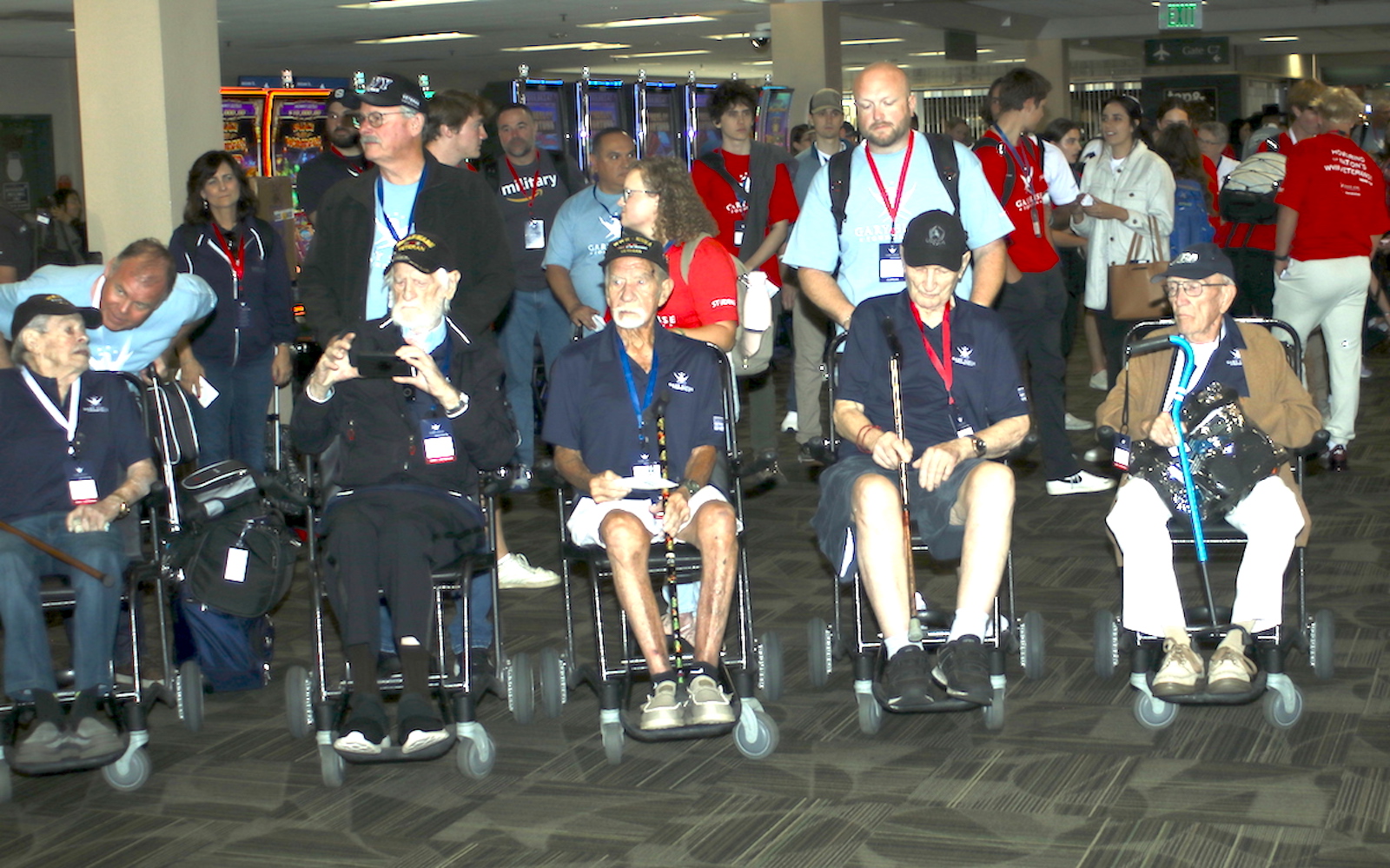
Steve Ranson/Nevada News Group
Veterans and their guardians and Bishop Manogue High School students behind them are on their way to the departure gate.
“We picked the students based on character,” Haeberlin-Cope said. “We wanted students who would be loving and caring and so supportive as individuals. For many of them, it's hanging out with their grandparents. It was special to watch.”
Although Haeberlin-Cope was watching the interaction of her students, she also registered the veterans’ reactions.
“I was moved with the veterans,” she said, “and they were moved with the exhibits and experiences.”
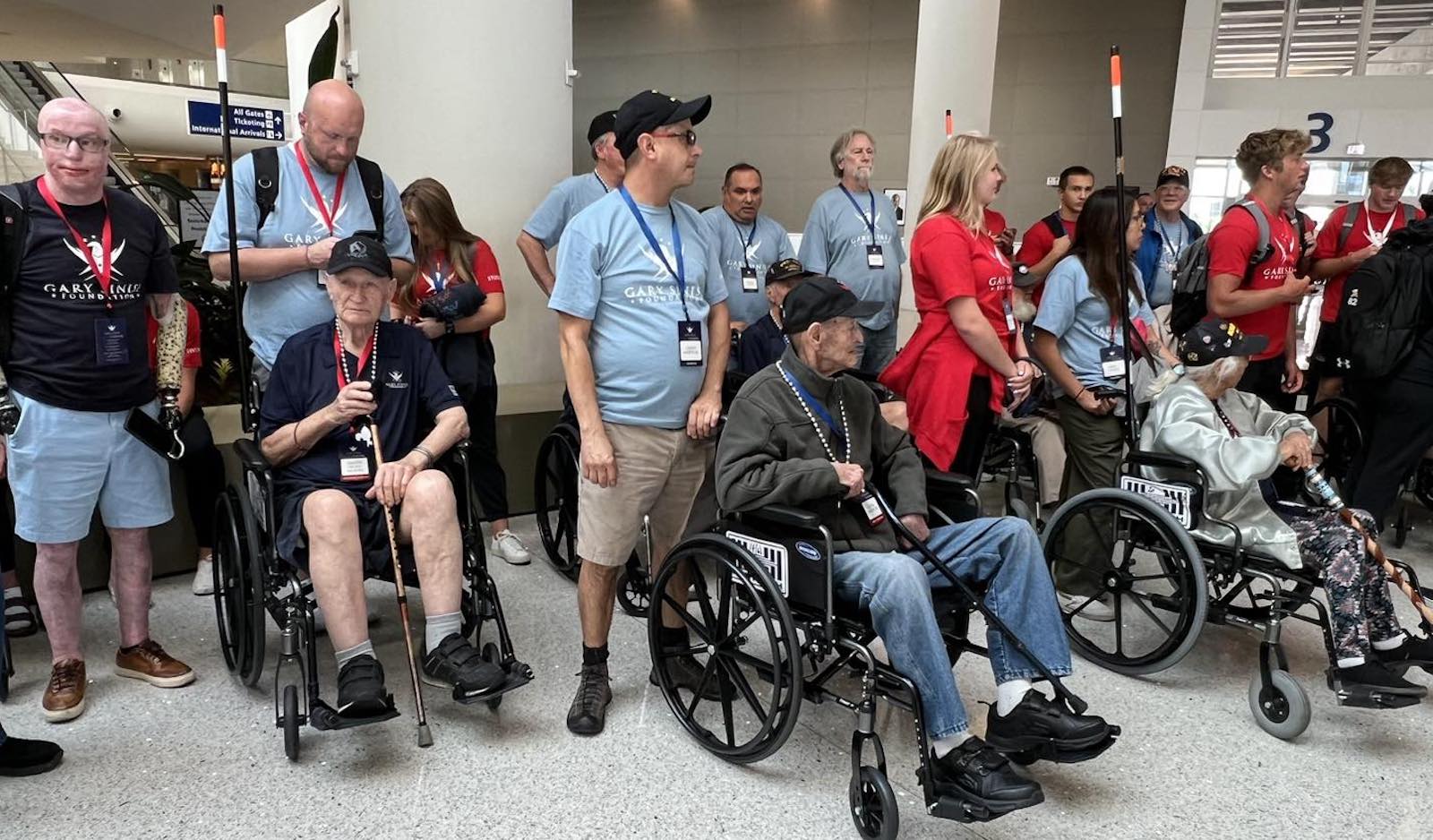
Courtesy Honor Flight
World War II veterans from Nevada, their guardians and students who attend Bishop Manogue High School are at the Louis Armstrong New Orleans International Airport.
Meeting history makers
Randy Stillinger, a U.S. Army reservist who doubles as manager of Military and Veteran issues for American Airlines, said the airline provided a special charter flight.
“It is a great experience,” he said. “It’s a three-day field trip for these students for they not only get to see the museum but meet with some of the history makers who were there.”
Stillinger said it is an honor to be part of this trip.
“We’re glad our flight attendants and pilots have donated their time for this special mission,” Stillinger said, adding American Airlines donates the jet for the flight to New Orleans.
Likewise, Jon Yuspa, executive director of Honor Flight Nevada, said his organization contacted the veterans to see who would be interested in flying to New Orleans with the students.
“They had a beautiful time there including our Holocaust survivor, Mitka (Kalinski),” Yuspa said.
For the veterans, the visit to the museum was a return to the past. For the students, the exhibits became their history teachers telling them about some of the crucial battles of WWII.
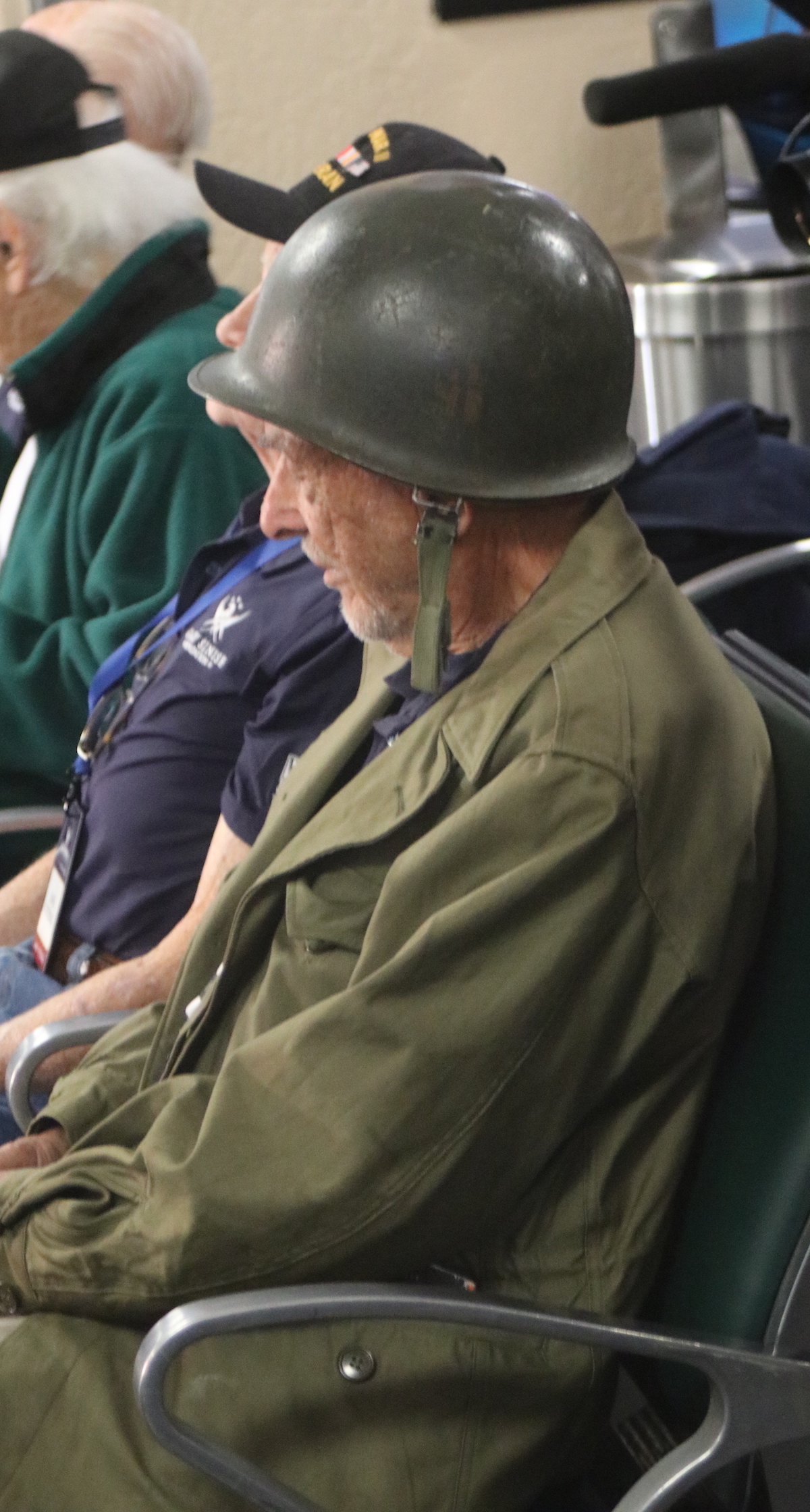
Steve Ranson/Nevada News Group
Army veteran Tony Pagano wears his combat helmet at the Reno-Tahoe International Airport prior to leaving for the World War II Museum in New Orleans.
“The whole event was beautifully planned. They cared about every little detail for the veterans,” said student Benjamin Enos. “I thought that was amazing. It reminds me of the Smithsonian Museum (Washington, D.C.). There is so much information.”
Enos said he was in awe of the full-sized aircraft hanging from the ceiling.
“You look up at the ceiling, and it’s full of aircraft that was awesome,” said Enos, who was paired with Marine veteran James Climo.
They then headed to the South Pacific section once inside the museum.
“I thought it was presented in the way they (curators) showed the events,” Enos said. “They re-enacted a jungle and showed the backgrounds and equipment that was used at the time.”
Enos said he a had a great-grandfather who was a Marine and severed in the Pacific. The Manogue senior said Climo had much to say.
“I enjoyed being around him,” Enos said.
Climo said the South Pacific exhibit was well done including the events of the time. Currently a resident of Sparks, Climo said he was also paired with another student, and they were very interested with the displays, as was his guardian Steve Ward of Yerington.
Sean McCorey said he was impressed with the authenticity of the artifacts and called the museum “immersive.”
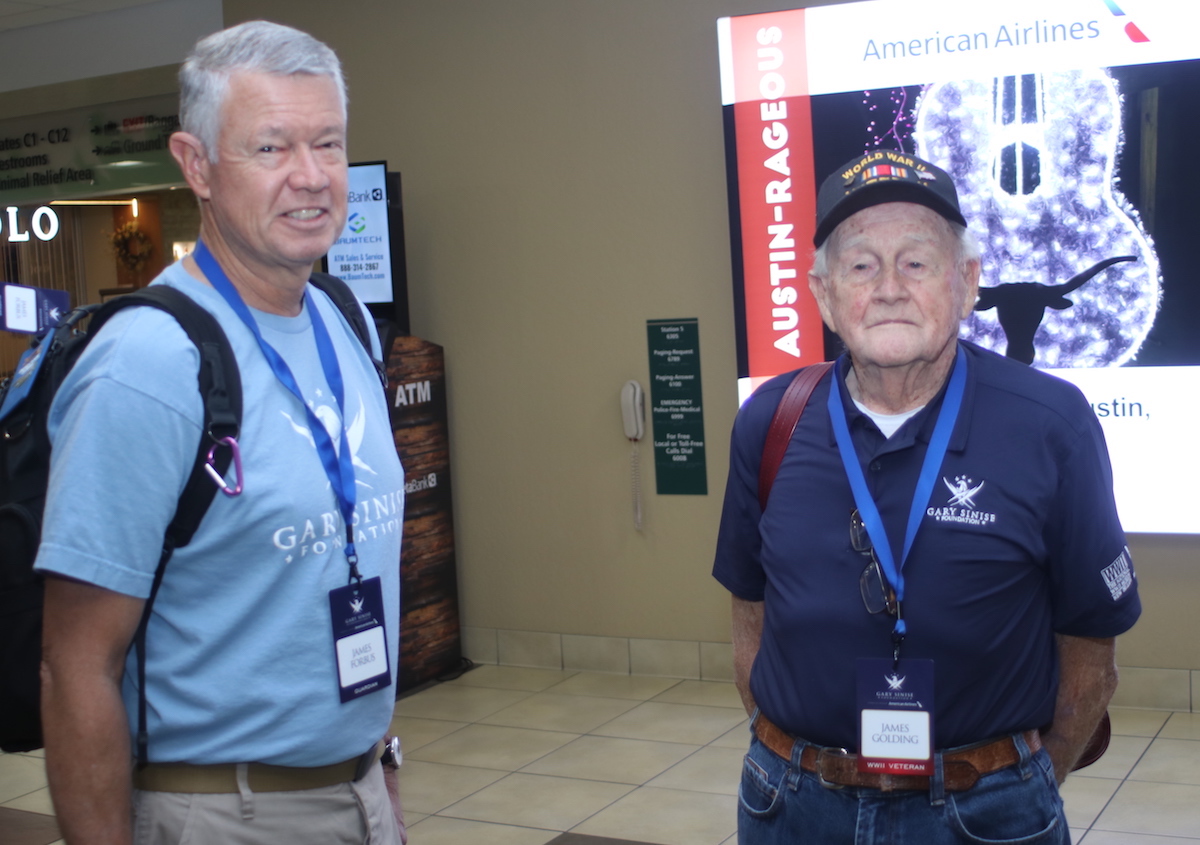
Steve Ranson/Nevada News Group
Guardian Jim Forbus, left, accompanies World War II veteran James Golding.
“I felt like I was really there (during WWII),” he said. “It was amazing, especially the movie. It knocked my socks off. I got a little scared,” McCorey said.
The Manogue senior has aspirations to become a U.S. Coast Guard officer, yet he was deeply interested in his veteran’s history. Robert “Bob” LeGoy enlisted in the Navy as a radar technician.
“He joined but was on a refrigerator ship on the way to Japan,” McCorey said of the YP-415, adding LeGoy knew something was going to occur against Japan in the latter days of the war.
McCorey said he was also inspired by LeGoy and his resolve to enlist and fight for his country.
“He knew we were on the other side (of the world) and he went,” McCorey added.
LeGoy, who was accompanied by his son Phillip, said the three of them were fascinated with the South Pacific exhibit. He said the movie made his eyes water. Phillip LeGoy, who spent four years in the Coast Guard, also offered information on the academy to McCorey.
Bob LeGoy, a retired Reno newspaper advertising and marketing executive, said the sidewalks at the museum contained thousands of bricks with embossed names on them. He enjoyed the singers belting out songs from the WWII era.
The 98-year-old LeGoy said the dropping of two atomic bombs on Nagasaki and Hiroshima in August 1945 changed his ship’s mission. He said the YP-415 was part of an assembled armada positioning itself for an invasion of Japan, which was originally planned for Nov. 1.
Plans kept changing quickly, but on Sept. 2, 1945, aboard the battleship USS Missouri, representatives from the United States and its allies signed the formal Instrument of Peace with Japan. In four months, Le Goy headed home and enrolled at the University of Nevada.
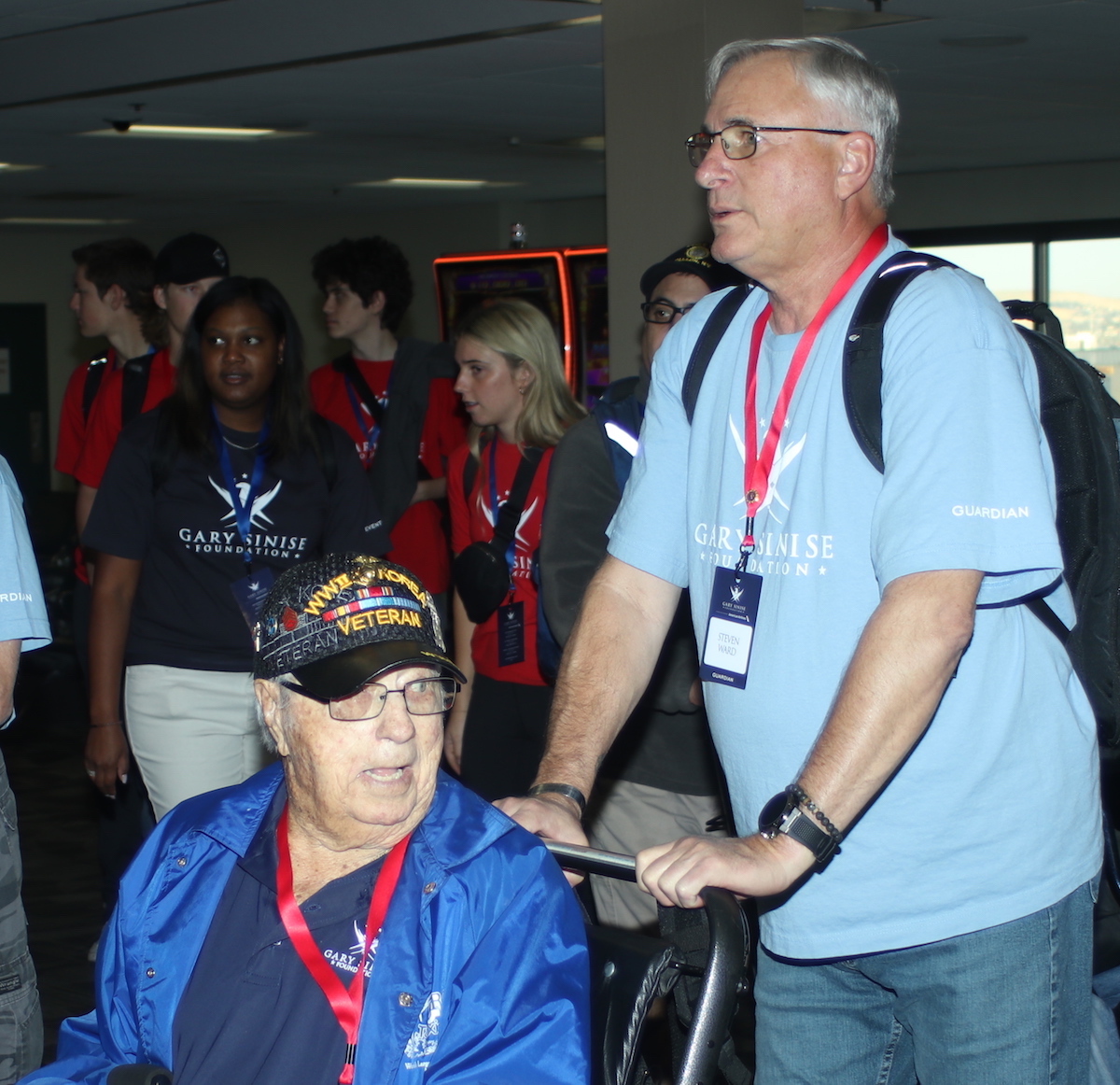
Steve Ranson/Nevada News Group
Steve Ward, right, pushes Jim Climo’s wheelchair at the Reno-Tahoe International Airport.
Their love to fly
Manogue student Couper Ross and Jim Golding of Diamond Spring, Calif., bonded quickly. Ross is a 17-year-old who loves to fly, and Golding has his private pilot’s license. After the trip to New Orleans, Golding met Ross at the Reno-Stead Airport and took him flying in his plane.
“I was amazed with his background and learned a lot about his time in and after the military,” Ross said. “He was stationed in Panama looking for submarines. He never saw any submarines, but they all did a lot of testing.”
Ross said it was difficult to imagine the Allies fighting on two fronts during the war and to be 16 years old. Ross wondered if he would’ve graduated from high school or entered boot camp and served.
Ironically, the 96-year-old Golding never served in the Pacific Theatre or Europe. Most of this duty occurred in the Caribbean where the nine-man crew of a Martin PBM Mariner performed submarine watch with 2,000-3,000 rounds of ammunition for each one of the three turrets. The PBM Mariner used in the Caribbean region was a twin-engine American patrol bomber flying boat that kept the Panama Canal and surrounding area safe.
Golding, who was a young 17-year-old tail gunner at the time, still has a sense of humor from his enlistment.
“I walked into the recruiting office and said here I am,” he chuckled.
In a short time, though, Golding found himself on a train headed to Norman, Okla., where he learned his basic skills and then back to Jacksonville, Fla., to complete his advanced schooling.
“I then shipped to Norfolk (Virginia) for staging. We were put on a boat to Panama,” he said.
Golding said the Mariner didn’t have wheels because it landed on water.
“Most of our flights were 9 to 10 hours on antisubmarine patrol,” he said.
Most of the time, Golding said they flew from Panama to Guantanamo Bay on the northeastern shore of Cuba. Occasionally, he said the crew would fly north to Florida to provide additional pilot training and to practice aerial reconnaissance.
“We’d practiced shooting our targets,” said Golding, who spent 1944-1948 in the Navy.
While in Panama, Golding said the crew was based at Coco Solo.
Years later, Golding and his wife took a cruise across the Panama Canal, and he was able to remember many of the landmarks from the mid-1940s. During WWII, Coco Solo was a Naval Air Facility on the Atlantic side and housed a squadron of U.S. Army Air Forces P-38 Lightning aircraft.
Aiden McCaffery was also shocked by the youthfulness of the WWII veterans like Golding.
“It relates everything into perspective,” he said. “I stress over tests and things like that, but they were stressing about going to war.”
McCaffery said his veteran, a medic by the name of Cyrus, entered the military near the end of the war.
“I heard all the stories,” McCaffrey pointed out.
Manogue student Ryan Clark said the museum features the “real relics” that were used more than 75 years ago. He said John Cristando spent two years in Europe with the Army.
“He was realistic about what it was like,” Clark said, adding Cristando was with a howitzer unit. “He stayed afterward to liberate the concentration camps.”
Eva Wathen said visiting the museum and looking at the different exhibits gave her a different perspective. She said her paired veteran, Pagano, provided her with many interesting stories of the time he spent in Europe during the latter part of the war.
“He said it’s important to remember all the people who died and aren’t here today,” Wathen said, adding Pagano mentioned those who suffered survivors’ guilt. “He told me he had 12 friends who died all in the same day. He was the only one of his entire group of friends who survived.”
Wathen said she can’t envision living with that feeling. During her history classes, she said the students learn only the basics.
“Hearing the basics from a person who actually was there changes that time period,” Wathen reasoned. “We are lucky enough to be living in a pretty peaceful time in the United States.”
Crossing paths
“Tony Pagano served in the Army under (Gen. George) Patton. He and Mitka (Kalinski) probably crossed paths,” Yuspa said.
When Mitka was a 7-year-old Ukrainian boy, Nazis invaded his homeland in the early 1940s. In one roundup that included Mitka, the Nazis killed hundreds of Ukrainians in a ravine. Mitka survived by hiding under the bodies and later crawling out. The Germans later picked up Mitka when they saw him walking along a road and put him on a cattle car destined for the Auschwitz-Birkenau concentration camp.
Mitka moved frequently from Auschwitz to Buchenwald and then Dachau, the first Nazi concentration camp, in southern Bavaria near Munich. His final camp was Pfaffenwald before a German officer, Gustav Dörr, and sister Anna, took Mitka to their farm at Rotenburg an der Fulda in 1942 and forced the youngster to be a household slave until American soldiers freed him seven years later.
Yuspa said Pagano saw action with Patton’s 3rd Army at Battle of the Bulge during the cold, snowy winter from mid-December 1944 to the end of January 1945. The 18-year-old Pagano was a combat engineer with the 1225th Engineer Battalion, and records show he’s only one of four surviving soldiers who holds that distinction. The battalion supported the 87th Division during the Battle of the Belgium, which became the last major offensive for the German army.
The 97-year-old Pagano said he was happy to be associated with the students during their trip. He said the journey to the WWII Museum conjured memories of his service. He told the students he became a physician after the war because of his military time. Furthermore, Pagano said he had respect for the medics who served during the war because of the intense stress they felt not to be killed by the enemy.
“The highest rate of mortality in the Army, and people who don’t realize it, are the medics,” he said. “I remember the young people I left behind. Twelve of my friends are buried in Luxembourg.”
The 50-acre cemetery is not only the final resting place for Patton but also for 5,074 American soldiers and airmen.
Although he never received the Purple Heart, Pagano, nevertheless, brought a reminder of his military service to New Orleans: a helmet he wore in the Army.
Manogue senior Audrey Sheldon said she was smitten with the interactive stories.
“It’s truly an interactive story to walk and live through the war along with the veterans,” she said. Sheldon was paired with Navy veteran and Carson City resident John Lucky.
“I was able to learn his story from when he first enlisted at the age of 16 through his military service and when he got out,” she said. “I learned about his family, and he had a lot of interesting stories.”
Sheldon said Lucky, 94, was determined to join the war effort and serve his country.
“He told his mom he was going to enlist or run away from home,” Sheldon said. “It takes courage to say that and do that.”
Lucky formerly resided at Lake Tahoe for 20 years and has lived in the Indian Hills area south of Carson City for more than 15 years. His heart, though, still belongs in the mountains.
“I like the lake better, but I didn’t like the snow,” he added.
During his 12 years of military service, Lucky served in Japan as part of the occupation forces and in both Korea and the Philippines.
Heading to Japan in 1946 took many hours and involved island hopping for fuel stops. First, the planes flew to Hawaii and then to Johnson Island and eventually to Japan. Lucky, an aviation boatswain mate, ensured once the plane landed on its floats, he attached the wheels. During the crew’s time in Japan, they took aerial photos.
From the western Pacific, Lucky said the Navy transferred him to a number of stateside bases. He returned to the former Alameda Navy Air Station and then to air stations at Grand Prairie, Texas, and Los Alamitos, Calif.
Lucky, who grew up in Louisiana, met his future wife while serving in the Navy and married her.
“I should’ve stayed in 20 (years),” he said. “I kept getting shipped out every time after I came home. My wife said no more.”
While Lucky and the students reflected on WWII at the New Orleans museum, he also reminisced about the war and his service when he visited Pearl Harbor with Honor Flight Nevada two years ago. Lucky also attended the local 75th anniversary ceremony of Pearl Harbor which was conducted behind the Nevada Capitol at the USS Nevada Memorial.
On board of the battleship USS Arizona, Lucky thought of the 1,177 sailors and Marines who were killed during the Japanese attack on Oahu.
“We lost a lot of men,” he said.
Comments
Use the comment form below to begin a discussion about this content.
Sign in to comment